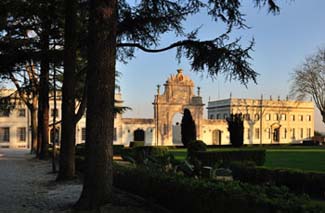
Photos courtesy of Tivoli Palácio de Seteais
Rua Barbosa do Bocage, 10
2710-517 Sintra
Tel: ++351 219 233 200
Fax: ++351 219 234 277
Hotel website
Reserve with Booking.com
30 rooms, including 1 suite, 16 doubles, and 13 twins
Double rooms: from 255 euros
Rates include breakfast, tax,
and service.
Packages available.
Open: all year
Sintra is about 20 km northwest of Lisbon. The hotel is about 1 km west of Sintra on the Colares road. Bus connections are available from Lisbon, Cascais, and Estoril, and trains leave every 20 minutes from the Rossio Station in Lisbon.
On site: swimming pool;
tennis
Nearby: golf; Pera Palace,
Royal Palace, walk through
Sintra; excursions to
fashionable resort towns of
Cascais and Estoril.
In “Childe Harold’s Pilgrimage,” Lord Byron wrote that the setting of Sintra was one of the most delightful in Europe, with its “palaces and gardens rising in the midst of rocks, cataracts, and precipices; convents on stupendous heights—a distant view of the sea and the Tagus.”
This beautiful setting and its cool climate made Sintra the favorite summer residence of Portuguese kings for six centuries.
Besides the natural beauty of ocean vistas seen from nearly 600 meters, the area is rich with tropical and subtropical trees and flowers.
The Seteais Palace has a triumphal arch connecting the two wings of the building. It is said to commemorate a visit by the prince and princess of Brazil in 1802.
Palace interiors are just as elegant 200 years later. Paintings, Flemish tapestries and rosewood and mahogany antiques—including some nice grandfather clocks—fill the public rooms. The spacious halls have high ceilings and marble or wood floors. Flowers, vines, and murals are painted on many of the walls.
Each of the large and comfortable guest rooms is decorated with upholstered furniture, antiques, and big mirrors. Three have hand-painted wall murals. Bedrooms on the first floor have extra-high ceilings. Recent renovations have modernized the bathrooms and added plasma TVs to every room.
The dining room has gold-painted walls and crystal light sconces and is considered one of the best restaurants in Portugal. It offers complete four-course meals. You can also dine on an outdoor terrace.
The hotel sits on spacious grounds. A labyrinthine garden in back overlooks the valley below.
![]() Excellent service
Excellent service
![]() Lovely views
Lovely views